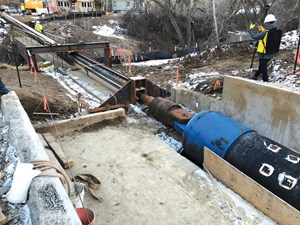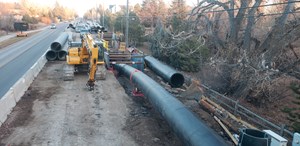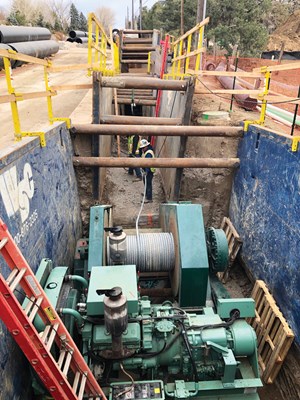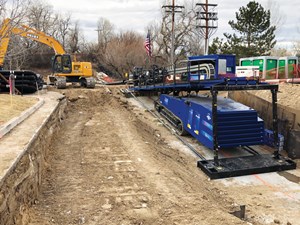December 2019 Vol. 74 No. 12
Features
Sliplining with an HDD Twist
By Jeff Griffin, Senior Editor
Teamwork among organizations with multiple skills and specialties is credited with rehabilitating a vital 1.5-mile-long segment of the sanitary sewer system serving two Denver, Colo., suburbs.
The Colsman Tunnel is an essential part of the Big Dry Creek Interceptor sanitary sewer system serving the communities of Greenwood Village and Centennial. The system is owned and operated by the Southgate Sanitation District (SGSD).
Constructed from 1976 through 1978, the mushroom-shaped dimensions were 5 feet, 9 inches high with widths ranging from 4 feet, 3 inches to 10 feet. The interior was lined with wire mesh, shotcrete and coated with coal tar epoxy.
Over the years, the tunnel had become badly deteriorated with serious structural defects and was experiencing groundwater infiltration. In 2015 a multi-sensor robotic inspection was performed by SGSD. HDR Engineering provided a tunnel condition report, which identified structural deficiencies, corrosion, surface spalling infiltration and lining defects. The report recommended action to restore and renew the tunnel.
Based on the age of the tunnel, its continuous exposure to highly corrosive wastewater environment, the inability to safely perform internal spot repairs and a lack of redundancy in the event of failure, the district became increasingly concerned with the reliability of the tunnel. Even partial failure could have resulted in a significant environmental emergency.
Clearly there was a risk of failure, and there was no alternative infrastructure capable of delivering flows from the service area to the outfall system, and there was no system redundancy if operation of the tunnel flow was interrupted.
Recognizing that repair or replacement was imperative, SGSD turned to Burns & McDonnel Engineering to evaluate available options for the Colsman Tunnel.
Because of the complexity of the task and the construction challenges it presented, the decision was made to use the design/build method of construction, which allowed hiring of partners to manage the technical aspects and construction in a team environment, along with phasing, procurement flexibility and the implementation of an accelerated construction schedule.
Design/build
Garney Construction and Dewberry Engineering were hired as a design/build team, and Shannon & Wilson was added to provide tunneling, geotechnical, and geo-structural support.
Ultimately, the decision was made to proceed with a variation of the sliplining process, pulling in rather than pushing through new pipe. Installing HDPE would provide a fully structural, completely inert and continuous pipe. Sliplining could be completed in live flow conditions, which eliminated the need for expensive, high-risk, and zero return-on-investment bypass pumping.
Global Underground was added to the team as subcontractor to provide HDPE pipe fusion, joint fusion recording and sliplining pipe pull in using horizontal directional drilling equipment
(HDD). ISCO Industries supplied and coordinated delivery with Garney of the 48-inch SDR 13.5 IPS (PE4710) HDPE pipe, manufactured by WL Plastics. Ultimately more than 1.6 million pounds of pipe would have to be pulled into the tunnel. Construction was considered substantially complete in late May 2019, eight months after work began.
Reflecting on the project, Global President Robert Meadows credits teamwork of all involved in successfully completing the difficult project safely, under budget and at a fraction of the cost of other feasible solutions. It was accomplished through teamwork, creativity and exceptional problem solving.
“There are times,” Meadows said, “when challenges bring extraordinary opportunities, and such was the case
with the Colsman Tunnel project.”
Meadows said the tunnel had been built using hand tunneling and road construction equipment in use at the time. Earth cover varied from nothing at the entrance and outlet structures to 90 feet near the midpoint. The tunnel was constructed with a downward slope of 0.36 percent. After mining the tunnel through sandstone, siltstone and shale of the Denver Formation, it was lined with shotcrete applied over wire mesh and then coated with coal tar epoxy.
class="BodyCopyChapPro1012">Meadows summarized the steps involved in sliplining the tunnel. To begin, Garney Construction secured and prepared safe work zones, lay-down areas, site access and traffic control procedures and barricaded street lanes for the excavation, demolition, construction and sliplining operational control needs at both ends of the tunnel
A major challenge was how to securely anchor the American Augers DD-440 directional drilling machine that would install the pipe. Initial calculations predicted the pullback load would approach 660,000 pounds to pull the 1.6 million-plus pound pipe string into place.
The primary components of the anchoring system included 12 by 170 feet vertical beams to secure the drill rig in place, three sheet pile curtains 25-, 35- and 25-feet wide and driven 17-feet deep, horizontal beam reinforcement located behind each of the sheet pile curtains and a 2-foot thick reinforced concrete pad that sloped away from the tunnel. The HDD set-up angle was 10 degrees and the negative 8-degree anchor pad slope allowed for final adjustment and drill-rig placement to ensure that the required negative 3-degree tunnel entry angle was precisely met. These conditions had to be met to ensure the insertion and pull back operations did not damage the tunnel roof, sides, or floor.
Due to site restrictions the drill-rig anchorage point had to be located over 175 feet from the tunnel inlet. In order to control the unsupported drill stem pipe length over a live stream, a drill stem bridge and guide system also had to be designed and constructed.
Inserting drill pipe
One of the most complex challenges was successfully inserting more than 7,800 linear feet of 65⁄8-inch steel drill stem weighing over 297,000 pounds into, through and safely out of the 7,632-foot tunnel without causing damage or losing control of the drill stem string.
Global provided a creative solution with a 120,000-pound pull industrial winch, modular sheave roller, rope/cable and re-spooler system. First the winch was placed just beyond the tunnel outlet, then at the inlet a buoy was floated downstream with a 1⁄4-inch rope attached. The rope was captured at the exit portal vault, threaded through the modular sheave roller system to keep the rope and cable from cutting into the tunnel roof and connected to the winch.
Rope/cable was progressively upsized to larger diameters and strength until a 1½-inch steel cable was pulled through the tunnel. The cable was connected to the drill stem string using a 58-ton swivel and 16-inch diameter safety pig to prevent coiling/recoiling and floor and wall damage.
Global used its American Augers DD-440T (440,000 pound thrust/pullback capacity HDD drill) to connect the drill stem string together and pushed as the cable tension on the winch was carefully monitored while the string was pulled directly through the tunnel. After all of the drill stem was inserted, the swivel and pig were removed and replaced by a 550-ton swivel which would connect to the reinforced pulling head assembly and HDPE pipe string. The assembly was sealed to prevent contamination from entering the HDPE pipe string as it was pulled thru the live wastewater flow.
Global fused a 42-inch Polycam DR11/steel pulling head to a 42x48 DR11 concentric reducer to a 48-inch DR13.5 pup, not to exceed the retrieval flume length of 17 feet, 6 inches. Customized design of internal reinforcement included a 30-inch DR11, 1-inch thick steel pipe inserts, optimal symmetrical pattern of 11⁄4-inch bolt/nut connections, DR13.5 wall wedges and watertight seal disc. They were fabricated in-house to obtain maximum pull force strength.
Most pipe fusing was conducted inside a tent that enclosed a McElroy 1648 fusion machine provided by ISCO. Fusion parameters were predetermined by PPI, ISCO, WL Plastics and Global Underground engineers and technicians.
The wall thickness on the pipe was 3.55 inches and weighed 218 pounds per foot. It was butt fused according to ASTM F-3183. The average facing time was 15 minutes. The pipe ends were held against the heat plate (400–450 degrees F) at an interfacial pressure of 65 psi for a 25-minute heat soak period. After the heater plate was removed, the pipe ends were forced together at an interfacial pressure of 1,000 psi with 100 psi drag pressure for one hour to complete the fuse.
Quality of fuses was verified using a McElroy DataLogger 6 with a link that downloaded the joint information to the McElroy Vault. The fusion manager would immediately analyze the joint.
Careful monitoring
During pipe pullback with the HDD drill unit, rig pressures were monitored constantly for maximum allowable forces and for changes which would indicate a potential problem in the tunnel. The rotation of the drill head also was monitored to help predict any unwinding behavior of the pipe after the pull was competed and when the in-place pipe was allowed to relax. Once the pipe string was in the exact retrieval location the pull-head was cut-off and removed. Pullback pressures remained lower than engineering estimates, and Garney restrained the pipeline at the tunnel entrance and installed the barometric loop at the tunnel exit.
To fuse and completely pull the pipe string through the tunnel took 42 days. After the pipe was in place, grouting began by subcontractor Cematrix.
Meadows said low-density cellular concrete (LDCC) was used to minimize the risks associated with pipe floatation during grouting and the high heat of hydration that would be experienced with traditional cement grout. The grout had an initial appearance and consistency of a light foam. After curing, it hardened and looked more like pumice. It took about 7,400 cubic yards of LDCC pumped in from the east portal through four ventilation shafts and through nine new grout injection ports.
After grouting, the entry and exit portals were replaced. The upstream portal building was replaced with a buried vault structure which provides plenty of access while eliminating a structure with odor control and other operational and maintenance concerns. The downstream portal was rebuilt and refurbished. Both were coated with wastewater-specific structural cements and an epoxy topcoat that should provide more than 50 years of service life without damage in the highly corrosive environment.
Throughout construction, there was minimal interruption of traffic flow in the area.
“The Colsman Tunnel presented many significant design and structural challenges,” said Mike Lehrburger of Burns & McDonnell. “But it was completed under budget, with no sanitary sewer spills, and without major safety incidents.
“The total project cost was less than half the cost of many of the other engineering solutions considered. By all metrics, the project was a fantastic success because multiple stakeholders joined together to operate as a cohesive team.
“It took the willingness of each partner to try something new, and any time a challenge arose, team members shared their knowledge and experience to develop the best resolution.
“The Southgate Sanitation District and its customers can now be certain that their most critical and expensive piece of infrastructure will serve them far into the foreseeable future.”
Steve McCandless, who worked with Garney Construction for 40 years and was a major contributor to the success of the Colsman Tunnel project, passed away soon after its completion. “Steve is lovingly remembered by all who knew and worked
with him,” said Robert Meadows. •
FOR MORE INFORMATION:
Global Underground Corporation, (719) 471-7414,globalug.com
American Augers, (800) 324-4930, americanaugers.com
McElroy Manufacturing, (918) 836-8611, mcelroy.com
ISCO Industries, (800) 345-4726, isco-pipe.com
Garney Construction, (816) 741-4600, garney.com
Dewberry Engineering, (303) 825-1802, dewberry.com
Shannon & Wilson, (303) 825-3800, shannonwilson.com
WL Plastics, (682) 831-2700, wlplastics.com
Cematrix, (888) 876-0484, cematrix.com








Comments